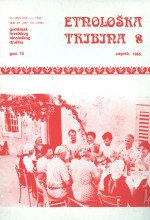Tradicijska ishrana u suvremenim uvjetima u selu Cernik kraj Nove Gradiške
Contemporary Usage of Traditional Foods in the Village of Cernik near Nova Gradiška
Author(s): Tomislav ĐurićSubject(s): Customs / Folklore, Ethnohistory, Modern Age, Recent History (1900 till today), Cultural Anthropology / Ethnology, Rural and urban sociology
Published by: Hrvatsko etnološko društvo
Keywords: Cernik; traditional food; 16th to 20th century; Cernički krmokolj; St. Vincent's day;
Summary/Abstract: Written records about the Cernik village date back to the 12th century. In the period of Ottoman rule it was the seat of a sandžak (1593—1687). In the 18th century, Franciscan monks built a baroque monastery and the church there, and established a public school. The aristocratic family Kühner renovated the existing medieval fortress, transforming it into a baroque residence. In 1905, the Croatian Singing Society »Tomislav« was formed, taking the lead in the cultural and educational activities. In order to preserve the old Slavonian tradition of specific rituals and food preparation, in 1983 the »Tomislav« Society instigated a manifestation named Cernički krmokolj (The Cernik Pig-Slaughter). It takes place at the end of November and includes mi exhibition of traditional dishes which are prepared and jointly consumed by the villagers and their guests in the village Cultural Center. There are about a dozen dishes and kinds of pastry on the menu, including such specialties as ćuptete (met pie) or pijanci (a pastry made of dough, sausage meat and white wine. .. .). Another occasion for the show of traditional food specialties is January 22nd — St. Vincent's Day — when bonfires are lit in vineyards and bacon grilled over them, followed by sausage and cold cuts dinner at home.
Journal: Etnološka tribina : Godišnjak Hrvatskog etnološkog društva
- Issue Year: 15/1985
- Issue No: 8
- Page Range: 49-54
- Page Count: 6
- Language: Croatian

